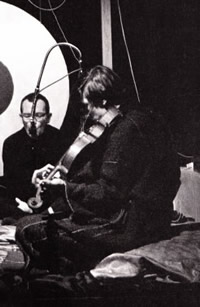

New York 1964-11-01
The Tortoise, His Dreams and Journeys with the Theater of Eternal Music led by La Monte Young at the Pocket Theatre in New York - October 30, 1964.
First of three public performances by the Dream Syndicate:) La Monte Young and Marian Zazeela (The Two Black Tigers), Tony Conrad (The Green Tiger), John Cale (The Hermit). They performed The Tortoise Droning Selected Pitches from The Holy Numbers for The Two Black Tigers, The Green Tiger and The Hermit. These titles were arrived at collectively using a kind of poetic stream of consciousness, the same mental process als produced Cale and Conrad's pet name for the group The Dream Syndicate. The inspiration came from Young and Zazeela's tortoise aquarium, whose drone they ampflified with the use of contact microphones. Young's desire for a "Wall of Sound" was realized by Conrad's ingeneous idea to use contact microphones. Also Marian Zazeela contributed to the visual aspect of performance by fashioning light-boxes and slide projections.
From the notes of La Monte Young:
The specific rules that governed the performance of my music, including the sections of The Tortoise, His Dreams and Journeys participated in by Tony Conrad and John Cale, create a sound characterized by the predominance of musical intervals whose numerators and denominators in just intonation are factorable by the primes 7, 3, and 2, and selected higher primes, especially 31, and by the exclusion of intervals whose numerators and denominators are factorable by the prime 5. If we represent intervals with numerators and denominators factorable by the primes 7, 3, and 2 in conventional music notation and terminology, we obtain intervals that include various sized major and minor sevenths (with emphasis on the septimally derived blues minor seventh in my compositions such as Bb Dorian Blues, Early Tuesday Morning Blues, Sunday Morning Blues, and The Tortoise), perfect fifths, octaves, unisons and their inversions, various sized major and minor seconds, and perfect fourths. The blues I was playing on the sopranino saxophone, directly preceding the period of The Tortoise, emphasized a technique I invented consisting of extremely fast combinationpermutations of a limited set of tones to simulate a sustained chord. And the chord I increasingly emphasized consisted of the pitches Eb, Bb, Db, Eb, (the IV-chord from Bb Dorian Blues) extended over the full range of the saxophone. Translated back into just intonation, these pitches are all examples of octave transpositions of the primes 7, 3, and 2.